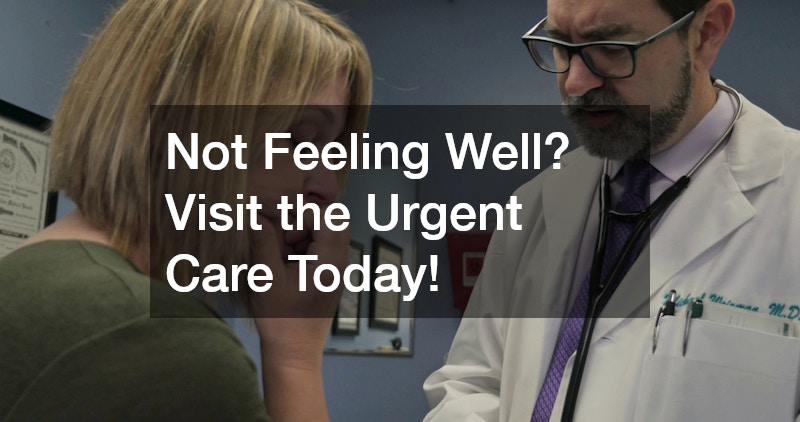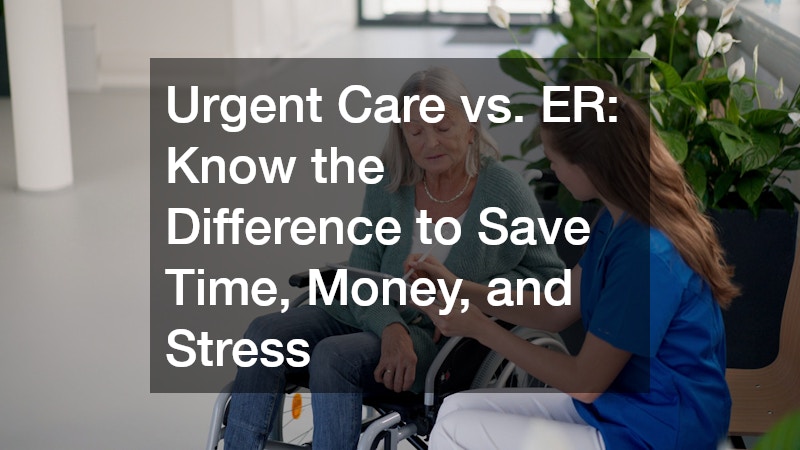Understanding when to choose urgent care over an emergency room can significantly impact the time and money spent on healthcare, not to mention the stress involved. The decision can mean the difference between a manageable expense and a financial burden. In this article, we will explore the crucial differences between urgent care facilities and emergency rooms, helping you make informed decisions when a medical situation arises.
What is the Difference Between Urgent Care and Emergency Room Facilities?
Definition and Scope of Services
Urgent care centers are designed to handle conditions that require prompt attention but are not life-threatening. These facilities typically treat ailments such as minor injuries, infections, and fractures.
Emergency rooms, however, are equipped to handle severe and potentially life-threatening conditions, offering a wider range of diagnostic tools and specialists.
Urgent care in Utah is an alternative for when your primary care provider is unavailable, offering services for non-critical issues. They provide faster service and shorter wait times compared to ERs. Emergency rooms, by contrast, are always open, ready for any crisis requiring immediate and intensive medical intervention.
The scope of urgent care includes treatments like stitches, x-rays, and lab tests for non-severe cases. ERs handle critical trauma, cardiac issues, and conditions requiring complex imaging or surgical intervention. Understanding these service differences can help determine where best to go based on medical needs.
Operational Hours and Accessibility
Urgent care centers generally offer extended hours beyond typical office times, though they are not open 24/7. Most are accessible seven days a week with availability on holidays to cater to sudden medical needs that aren’t emergencies. This makes them a convenient choice when you require medical help outside of normal business hours.
Emergency rooms, on the other hand, provide round-the-clock services 365 days a year. Their constant availability ensures that they can handle any medical crisis, regardless of the time of day or night. However, this increased accessibility can come with longer wait times, as priority is based on the severity of conditions rather than the order of arrival.
Accessibility is also impacted by location and community resources, with urgent care centers often found in suburbs and urban areas. ERs are typically located in hospitals, making them less accessible in remote rural areas. Knowing the operational differences and accessibility can guide you to the quickest care option.
Staffing and Expertise
Urgent care centers are typically staffed by primary care doctors, nurse practitioners, and physician assistants. While not equipped for critical care, they are experienced in diagnosing and treating common illnesses and injuries efficiently. Their training suits the less severe nature of cases they handle, but might require transfer to ERs for more severe cases.
Emergency rooms boast a comprehensive team that includes specialists like cardiologists, neurologists, and trauma surgeons alongside ER physicians. This diversity of expertise ensures that life-threatening conditions are promptly diagnosed and treated. ER staff are trained to manage critical conditions, providing life-saving interventions at a moment’s notice.
Understanding the level of care required can be pivotal in your decision. A more routine case may only need the generalists at an urgent care center, but complex issues require the specialists available at an ER. This can influence both the quality of care you receive and your overall healthcare experience.
When Should You Visit an Urgent Care vs. an ER?
Common Conditions Treated at Urgent Care Centers
Commonly treated conditions at urgent care centers include minor burns, sprains, and common infections like influenza or UTIs. When you experience symptoms such as a sore throat, fever, or minor fractures, these facilities can provide quick and effective treatment. They also offer flu shots, vaccines, and physical exams for convenience.
For non-life-threatening situations that cannot wait for a regular doctor appointment, urgent care fills an essential gap. They serve as a bridge between emergency rooms and general physician offices, offering immediate care for less severe medical needs. Choosing urgent care for minor issues can lead to lower expenses and shorter wait times.
People often visit urgent care to handle conditions that, if left untreated, could worsen but are not emergencies. Addressing these promptly helps in preventing the escalation of medical issues. The swift service and focus on non-critical care make urgent care a go-to for many health disturbances.
Situations Requiring Emergency Room Attention
There are critical conditions that necessitate a visit to the emergency room for prompt care. Symptoms of a heart attack, stroke, or severe head trauma demand immediate medical intervention, available only in ERs. Additionally, conditions like severe burns, loss of consciousness, and complex fractures also require the ER’s resources and expertise.
The ER is designed to handle life-threatening situations where every second counts. If you experience chest pain, difficulty breathing, or severe bleeding, the ER’s comprehensive diagnostic tools and specialists are necessary for effective treatment. Their ability to perform surgeries, administer advanced imaging tests, and provide resuscitation services is unmatched by urgent care facilities.
Choosing the ER for severe conditions can be life-saving, and it is crucial to recognize these scenarios. Understanding the signs that call for emergency care helps in making critical decisions swiftly. Having this knowledge ensures that you prioritize your health and safety in dire situations.
Guidelines to Help Make the Decision
To determine the appropriate facility, assess the severity of symptoms and the immediacy of your medical needs. If the condition involves severe pain, loss of function, or potential danger to life or limb, the ER is warranted. For non-life-threatening issues that cannot wait for a doctor’s appointment, urgent care is sufficient.
Consider factors such as proximity, insurance coverage, and wait times when deciding between urgent care and the ER. If unsure, use telemedicine services to consult with a healthcare provider, who can recommend the right course of action. This approach minimizes unnecessary stress and ensures you get the appropriate level of care.
It’s crucial to know when to dial emergency services as opposed to driving oneself to an urgent or emergency care facility. Recognizing symptoms such as chest pain or severe allergic reactions can guide you toward calling for ambulance assistance. These guidelines are critical in making informed healthcare decisions efficiently.
How Can You Save Time and Reduce Stress When Medical Help Is Needed?
Pre-emptive Measures and Health Management
Preventive health measures can greatly reduce the need for both urgent care and emergency services. Regular check-ups, vaccinations, and healthy lifestyle choices minimize the onset and severity of health issues. Staying informed on health practices equips individuals to make preventive strides against potential ailments.
Having basic first aid and medical supplies at home can also mitigate the need for urgent medical visits. Being prepared for common minor injuries or illnesses can delay or negate the necessity of professional intervention. These proactive actions reduce the frequency of medical emergencies, saving both time and resources.
Additionally, knowing your personal health risks allows you to take preventive actions more effectively. Engaging in regular physical activity, balanced diets, and stress management techniques contributes to overall health improvements. Preventive health behaviors foster well-being and reduce reliance on medical facilities.
Summarizing the key differences between urgent care centers and emergency rooms can empower you to make quicker and more informed decisions. Ultimately, understanding these disparities saves time, money, and stress when faced with a medical issue. Remember to always prioritize your health and safety when deciding which facility to visit.




